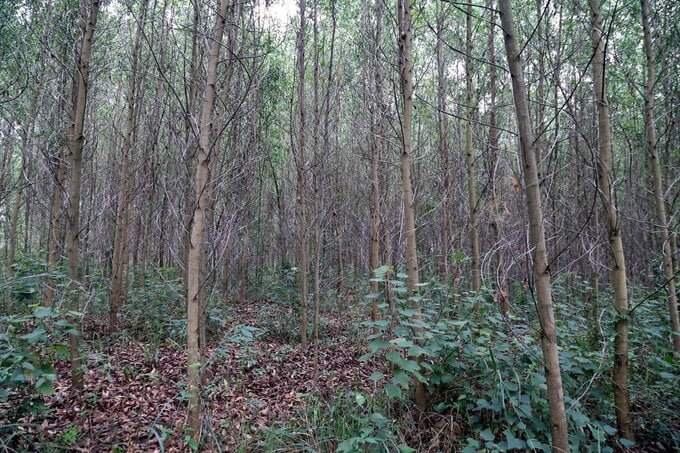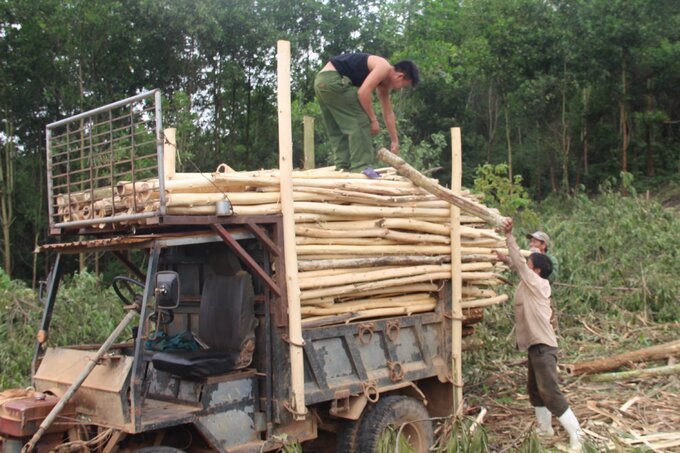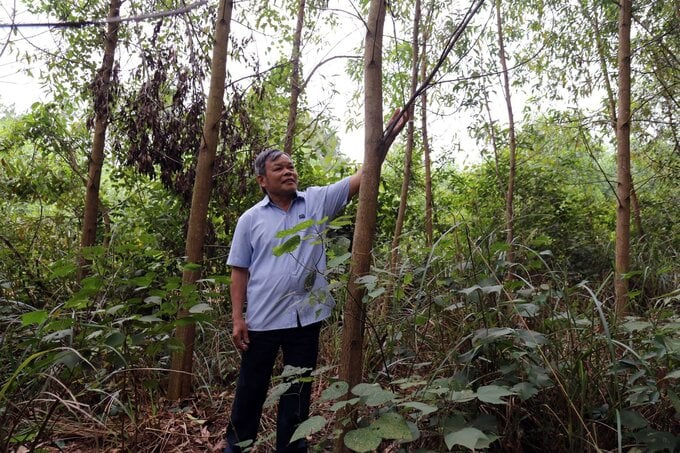November 26, 2025 | 21:06 GMT +7
November 26, 2025 | 21:06 GMT +7
Hotline: 0913.378.918
November 26, 2025 | 21:06 GMT +7
Hotline: 0913.378.918

Quang Tri province has over 121,000 ha of forests for production. Photo: Vo Dung.
According to statistics from Quang Tri’s agriculture sector, the whole province has over 121,000 ha of planted forests for production. The planting subjects are mainly acacia of all kinds, accounting for over 80% of the planting area. But cooperatives and local people are still planting small timber forests with a business cycle of 4-5 years and a density of 3,000 - 3,500 trees/ha. The small timber forests’ growth rate is slow, resulting in low economic efficiency.
Meanwhile, intensive plantation of FSC-certified large timber forests has recently become a trend as it will create 1.5 - 2 times higher economic efficiency than planting small timber forests. This is also one of the conditions for products from planted forests to be exported.
The benefits are visible, but forest growers still have many concerns about the technical procedure. A long business cycle possesses many potential risks due to erratic movements of weather and climate change.

Most of the planted forest area is mainly used for word chip factories. Photo: Vo Dung.
Le Bien Hoa in Trung Son commune, Gio Linh said that his family was associated with a business to plant sustainable forests. He also had his own hesitation at first, but when the business seemed so eager to persuade while giving out promises about output, he decided to switch to planting large timber forests according to FSC standards.
“They told me to just focus on growing the forest, and if I got the certificate, they would purchase timber at a price of over USD 20 per m3. I persuaded a few more locals to join. So far, the effect can be seen clearly. Planting large timber forests and FSC forests is much more economical than planting forests for wood chips. I will continue to nurture large timber forests to acquire FSC certificates." Hoa used to grow acacia with a cycle of harvesting once every 5 years, earning approximately VND 70 million/ha. Planting large timber forests with FSC standards, the cycle could last for 10 years and provide an income of over VND 200 million/ha.
Implementing large timber planting models is still not an easy matter. From 2014 to 2022 Quang Tri Agricultural Extension Center has implemented many large timber forest plantation models. Quang Tri’s goal is to become the center of planted timber materials in the Central region. These agricultural extension models, which will create a widespread effect within the community, are considered a stepping stone for that ambition.
In addition to raising awareness and encouraging forest growers to change their mindset and switch to planting large timber forests while gradually converting the ineffective small timber forests areas, Quang Tri Agricultural Extension Center has built many demonstration models.

The mindset of forest growers changed when many households switched to planting large timber forests and FSC-certified forests. Photo: Vo Dung.
Some mentionable examples include the Hybrid-acacia cuttings model applying wood quality improvement technology. Its implementation was from 2014 to 2017 on a scale of 25 ha. The forest was planted with an initial density of 1,660 trees/ha, and in its 7th and 8th years, the acacia forest is thinned, leaving only 500-600 trees/ha. After 8 years of growth and development, this model showed that the forest’s growth rate was fast and the wood quality was good enough to ensure a large timber supply rate of over 60% on the forest stand.
Quang Tri Agricultural Extension Center also implements models of converting small acacia wood forests to large timber forests in the 2018 - 2022 period with a total area of 96 ha. The model of planting large timber forests of hybrid-acacia tissues and Australian acacia mangium varieties is implemented from 2019 to 2022 with a total area of 156.5 ha. These models all show certain advantages. The most evident is the economic efficiency being1.5-2 times higher than growing small timber forests, not to mention the benefits to the environment.
“Quang Tri currently has more than 23,500 ha of FSC forest, of which over 3,100 ha belong to household groups. The remaining area belongs to three forestry companies in the area. Quang Tri is mobilizing organizations, households and communities to develop forests sustainably, aiming to secure 500 to 1,000 ha of forest certified by FSC every year. To realize this goal, changing people's thinking plays a decisive role,” said Deputy Director of Quang Tri Department of Agriculture and Rural Development Nguyen Hong Phuong.
Translated by Samuel Pham

(VAN) The model of making a living under the forest canopy through the agroforestry system in Van Son commune, Bac Ninh province, is expected to generate an annual income of approximately VND 30 million/ha.

(VAN) Many enterprises in Can Tho are harnessing natural energy and reducing greenhouse gas emissions in their production processes, thereby contributing to the promotion of a sustainable green transition.
/2025/11/24/3536-2-112800_176.jpg)
(VAN) Dong Nai now has tens of thousands of hectares of forests certified for sustainable management, and this area will continue to be expanded in the coming period.

(VAN) Vinh Ha hamlet (Dai Xuyen commune, Hanoi) is shifting away from small-scale farming as households adopt bioscurity into their breeder chicken models.

(VAN) Heavy rains make aquatic species more vulnerable to disease. Proactive water management and high-tech systems help farmers prevent outbreaks and protect yields.

(VAN) Greenhouses are shifting production mindsets in Binh Lu commune, enabling farmers to ‘weather the sun and rain’ and secure stable vegetable harvests throughout the year.

(VAN) Green transition is crucial for the Mekong Delta amid climate change and stricter standards, offering a path toward sustainability.